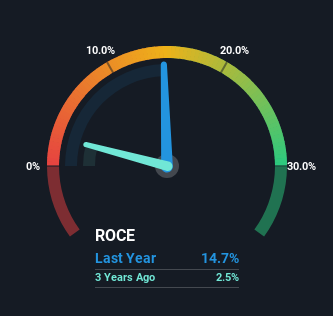- Israel
- /
- Aerospace & Defense
- /
- TASE:BSEN
Bet Shemesh Engines Holdings (1997) (TLV:BSEN) Might Have The Makings Of A Multi-Bagger

There are a few key trends to look for if we want to identify the next multi-bagger. In a perfect world, we'd like to see a company investing more capital into its business and ideally the returns earned from that capital are also increasing. Ultimately, this demonstrates that it's a business that is reinvesting profits at increasing rates of return. So on that note, Bet Shemesh Engines Holdings (1997) (TLV:BSEN) looks quite promising in regards to its trends of return on capital.
Return On Capital Employed (ROCE): What Is It?
For those who don't know, ROCE is a measure of a company's yearly pre-tax profit (its return), relative to the capital employed in the business. Analysts use this formula to calculate it for Bet Shemesh Engines Holdings (1997):
Return on Capital Employed = Earnings Before Interest and Tax (EBIT) ÷ (Total Assets - Current Liabilities)
0.15 = US$30m ÷ (US$292m - US$87m) (Based on the trailing twelve months to March 2024).
So, Bet Shemesh Engines Holdings (1997) has an ROCE of 15%. That's a relatively normal return on capital, and it's around the 14% generated by the Aerospace & Defense industry.
See our latest analysis for Bet Shemesh Engines Holdings (1997)

Historical performance is a great place to start when researching a stock so above you can see the gauge for Bet Shemesh Engines Holdings (1997)'s ROCE against it's prior returns. If you'd like to look at how Bet Shemesh Engines Holdings (1997) has performed in the past in other metrics, you can view this free graph of Bet Shemesh Engines Holdings (1997)'s past earnings, revenue and cash flow.
What The Trend Of ROCE Can Tell Us
Bet Shemesh Engines Holdings (1997)'s ROCE growth is quite impressive. More specifically, while the company has kept capital employed relatively flat over the last five years, the ROCE has climbed 141% in that same time. Basically the business is generating higher returns from the same amount of capital and that is proof that there are improvements in the company's efficiencies. It's worth looking deeper into this though because while it's great that the business is more efficient, it might also mean that going forward the areas to invest internally for the organic growth are lacking.
On a side note, we noticed that the improvement in ROCE appears to be partly fueled by an increase in current liabilities. Effectively this means that suppliers or short-term creditors are now funding 30% of the business, which is more than it was five years ago. It's worth keeping an eye on this because as the percentage of current liabilities to total assets increases, some aspects of risk also increase.
In Conclusion...
To bring it all together, Bet Shemesh Engines Holdings (1997) has done well to increase the returns it's generating from its capital employed. Since the stock has returned a staggering 125% to shareholders over the last five years, it looks like investors are recognizing these changes. With that being said, we still think the promising fundamentals mean the company deserves some further due diligence.
One more thing, we've spotted 3 warning signs facing Bet Shemesh Engines Holdings (1997) that you might find interesting.
For those who like to invest in solid companies, check out this free list of companies with solid balance sheets and high returns on equity.
If you're looking to trade Bet Shemesh Engines Holdings (1997), open an account with the lowest-cost platform trusted by professionals, Interactive Brokers.
With clients in over 200 countries and territories, and access to 160 markets, IBKR lets you trade stocks, options, futures, forex, bonds and funds from a single integrated account.
Enjoy no hidden fees, no account minimums, and FX conversion rates as low as 0.03%, far better than what most brokers offer.
Sponsored ContentValuation is complex, but we're here to simplify it.
Discover if Bet Shemesh Engines Holdings (1997) might be undervalued or overvalued with our detailed analysis, featuring fair value estimates, potential risks, dividends, insider trades, and its financial condition.
Access Free AnalysisHave feedback on this article? Concerned about the content? Get in touch with us directly. Alternatively, email editorial-team (at) simplywallst.com.
This article by Simply Wall St is general in nature. We provide commentary based on historical data and analyst forecasts only using an unbiased methodology and our articles are not intended to be financial advice. It does not constitute a recommendation to buy or sell any stock, and does not take account of your objectives, or your financial situation. We aim to bring you long-term focused analysis driven by fundamental data. Note that our analysis may not factor in the latest price-sensitive company announcements or qualitative material. Simply Wall St has no position in any stocks mentioned.
About TASE:BSEN
Bet Shemesh Engines Holdings (1997)
Manufactures and sells jet engine parts in Israel.
Flawless balance sheet and fair value.
Market Insights
Community Narratives



